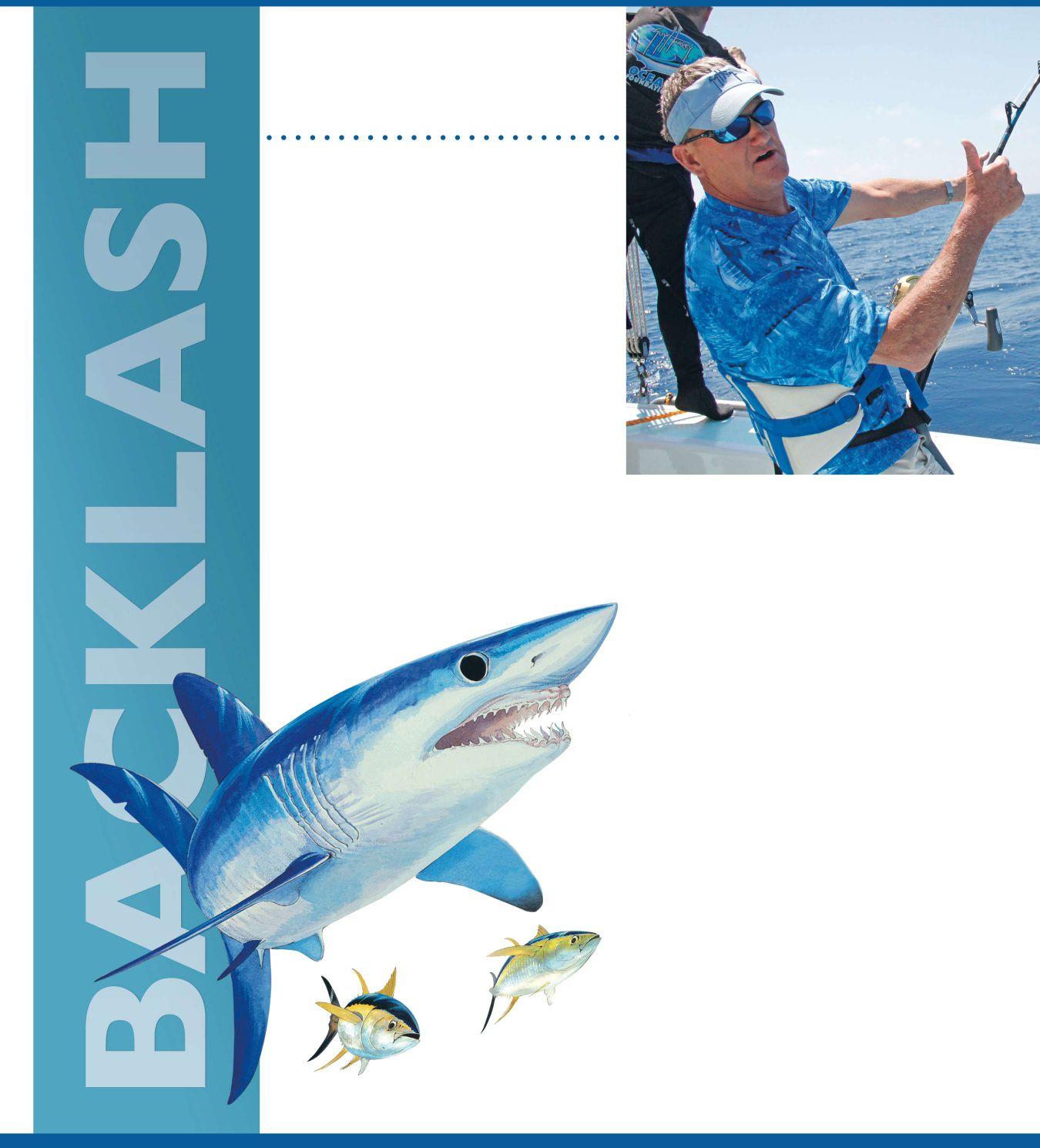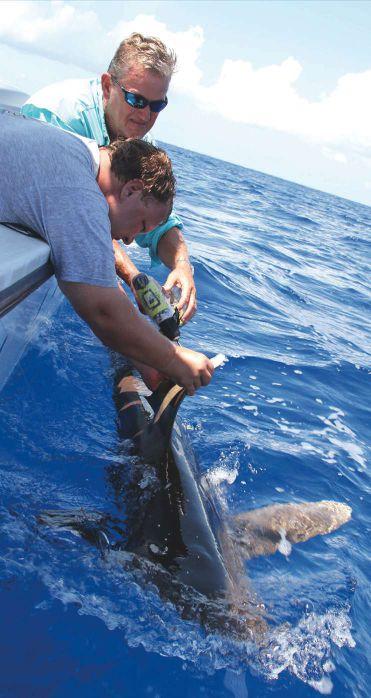
5 minute read
BACKLASH

THE FISHING BEHIND THE SCIENCE Guy Harvey
BY CA STAFF Everyone knows there ’ s some real science behind fishing—understanding how fish behave and the environment they live in and then applying that knowledge to catch a particular species. But in the world of Guy Harvey, there ’ s also a lot of fishing behind the science. That is, to study fish—especially to tag them and track them—you first must get them to the boat. This issue, we speak to Guy about the fishing side of his research and the techniques his team employs for catching marlin, makos and other awesome species.
Above: Guy, hooked up during a tagging expedition. Right: Attaching a shark tag. Photos: George Schellenger.
CA: How much of your fishing time
is purely recreational compared to time spent targeting fish for tagging studies or other research?
GH: I enjoy fishing for fun, any kind of fishing really, but I prefer offshore fishing. Fishing for blue marlin out of my home island of Jamaica, but more recently Grand Cayman, can be very exciting. Some of the best days recently are taking enough dive tanks to do three dives off the north wall and then going marlin fishing during the surface interval with my kids, Alex and Jessica. I also enjoy fishing alone in my 26’ Dusky Makaira. There is no one to ask “Where are the fish?” or, “Can we go home now?” And there’s no one to instruct on how to reel in a fish! It’s just me and the screaming reel, excitement and the roar of adrenaline in my ears. Over the years, I had several blue marlin on, even a double-header once back in 2008. I have caught four blue marlin on my own, up to 300 lbs. and tagged two of them with PATs (Pop-up Archival Transmitting tags). When in Panama at Tropic Star and not filming a TV show, I enjoy taking photos of the action. One of the ultimate challenges is to get a good, crisp shot of a jumping marlin, sail or dorado. You must be dedicated—no handling rods, baits, coaching people, etc. You must be ready at all times for the bite and consequent jumps.

CA: What steps do you
take to promote a healthy release, both in getting the fish to the boat and handling it once it is alongside?
GH: We use the greatest care in catching the fish. This includes securing, irrigating and recording length, taking a biopsy, then reviving and releasing the fish. Obviously, the bigger the fish, the longer it takes to catch and more time required to secure the fish alongside the boat. In placing a PAT in a sailfish or white marlin, we may board the fish on a wet mat to ensure perfect placement of the PAT, which costs $4,000 each. Big sharks like tigers and oceanic white tips will lie quietly alongside the boat once secured with a tail rope, even while having a SPOT deployed on their dorsal fin. I usually keep the boat in idle forward so water is forced over their gills.
CA: On a mako or other
tagging expedition, are you targeting fish of a particular size, age or gender? If so, how does that impact your fishing strategy?
GH: For the last five years, the GHRI research effort on mako sharks off Isla Mujeres, Yucatan, Mexico, has been rewarding. Under the direction of Captain Anthony Mendillo, we have tagged three dozen makos from 75 to 350 lbs. They are scarce, so we tagged whatever we caught. The first year, we used live bonito baits but found this limiting. The following year, Anthony trolled dead swimming bonito as well as skipping dorado baits with great effect. The real dorados were so effective that when they were unavailable, Anthony used cut out dorado decoys with spectacular results. We had many makos air out on the decoys. This year, we have reverted to traditional chumming. We now use a cage to film the makos as they come to the chum bucket really amped up and excited, biting at everything.
CA: Have there been
any memorable surprise catches while on a tagging expedition?
GH: There have been some oceanic white tips caught that were too small to tag with a PAT. We have tagged large tiger sharks up to 12 ft. (800 lbs.) and big blue marlin up to 500 lbs. One of the most disappointing results was to tag a 200-lb. black marlin on the Great Barrier Reef. As Bill Boyce and I filmed the release, a pack of bull sharks rose from below and ate the marlin, tag and all, in 30 seconds.
CA: This issue, we are
featuring the Riviera Maya region. You have conducted multiple tagging trips in the area. What makes it such a hotspot?
GH: The Yucatan has become one of the main research areas for GHRI because of the availability of different target species at different times of year. January and February are the months for sailfish work. March and April are the best months for makos. May and June are best for white marlin, sails and blue marlin. July and August is prime time for whale sharks and manta rays. The Gulf Stream pours north through the Yucatan Straights between Mexico and Cuba. This power ful current brings vast amounts of plankton for baitfish to feed on, so there are prolific quantities of sardines, bonitos and medium-sized predators on the shelf. The food chain works like this: sardines eat the plankton, bonitos and sailfish eat the sardines, and makos eat the bonitos and sailfish. Whale sharks and mantas feed on bonito spawn.
CA: Have you learned
anything while fishing on tagging expeditions that you or others might apply to recreational or tournament fishing?
GH: In diving and filming billfish for two decades, I have learned a lot about their behavior, especially how they attack prey and consume it. Sailfish, in particular, travel in small groups, so if you raise one, there will be more swimming with it, so expect multiple bites. White marlin often travel in twos and threes, so expect another fish to show up while you are fighting one. Release the fish in the best condition possible. Spend the time reviving a fish if it comes to the boat tail wrapped or very tired. I have learned that taking hooks out can injure billfish more than if you just cut the leader as close to the hook as possible. In trying to remove the hook, the billfish struggles vigorously and may bang its head against the boat, injuring the eyes. Also, I say no photos with billfish in the boat. Use a selfie -stick or Go-Pro to take shots of the team, the boat and fish while the fish is in the water.




